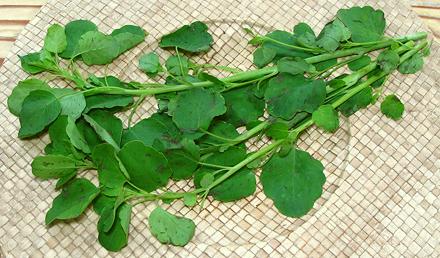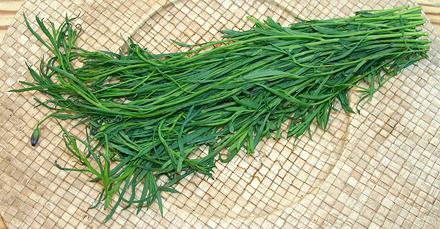These two plants look totally different, yet are closely related, taste very similar and are used pretty much the same. Most North American recipes that call for either of these recommend Cilantro as a substitute, but if you can add a few leaves of Rue, the flavor will be more similar.
More on Daisy Family - Herbs & Vegetables.
 [Bolivian Coriander; Pápalo (Mexico); Quillquiña (Bolivia);
Yerba Porosa, Killi, Tepegua, pápaloquelite:
Porophyllum ruderale]
[Bolivian Coriander; Pápalo (Mexico); Quillquiña (Bolivia);
Yerba Porosa, Killi, Tepegua, pápaloquelite:
Porophyllum ruderale]
Native to Mexico and South America, this plant, despite the English name "Bolivian Coriander", is not at all related to Coriander. Also note that it is one of two similarly used and closely related plants called Pápalo. The other one, with long thin leaves, is P. linaria. This plant grows to 5 feet high and 3 feet across. It is used as a culinary herb by many cuisines through its range, and is very popular in Pueblo in central Mexico.
Flavor is said to be like a mix of arugula, cilantro and rue, a
reasonable description, but the rue is a bit stronger than the other
flavors. The flavor is also slightly resinous. This herb is often used
in salsas and sandwiches. Note the wavy edges of the leaves. when it
starts to flower, the leaves become more elongated and the waves deeper.
Another interesting feature is that the leaves have a number of pinhole
like pores, thus "Yerba Porosa". Some is now grown in North America to
supply street sandwich vendors in Los Angeles and New York. I just love
this herb as a seasoning in hamburger patties. The photo specimens were
purchased from a large multi-ethnic market in Los Angeles. Leaves were
up to 2-7/8 inches wide.
 [Pipicha, Pepicha, Tepicha, Escobeta, Chepiche, Cola de coyote (Mexico);
Pápalo (incorrect): Porophyllum linaria]
[Pipicha, Pepicha, Tepicha, Escobeta, Chepiche, Cola de coyote (Mexico);
Pápalo (incorrect): Porophyllum linaria]
This plant visually resembles tarragon, but it doesn't taste like
tarragon - well, maybe just a hint. It is native to Mexico and used in
Mexican cuisine, often in meat dishes. Fresh leaves are also used as a
table condiment, particularly in Pueblo in central Mexico. The flavor is
similar to that of its close relative Pápalo,
but not quite as strong. It has been described as similar to Cilantro
but with overtones of Lemon and Anise. The photo specimens were sold as
stems about 13-1/2 inches long, with leaves about 1.4 inches long and
0.18 inch wide. They were purchased from a large multi-ethnic market
in Los Angeles. Picked just before flowering, they had a few unopened
purple flower buds. Note that this herb is sometimes called Pápalo,
a name that more properly belongs to the very closely related broader
leafed herb P. ruderale.